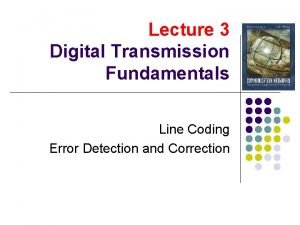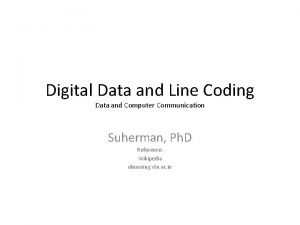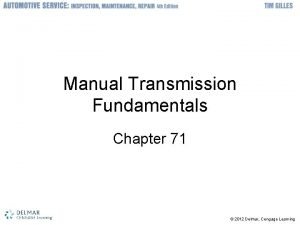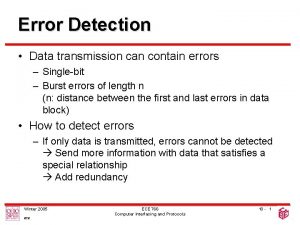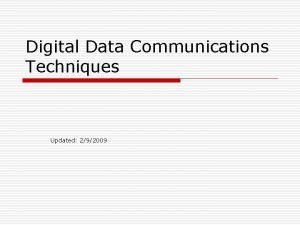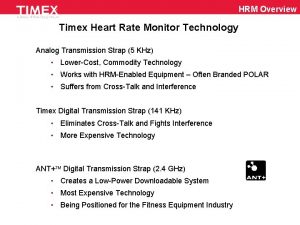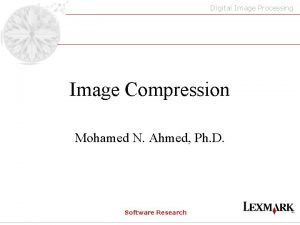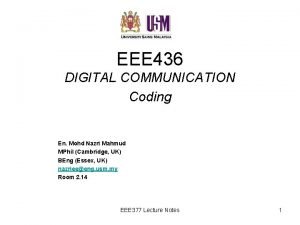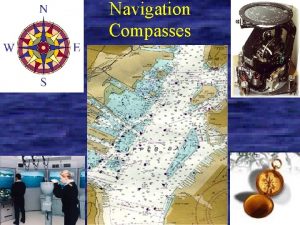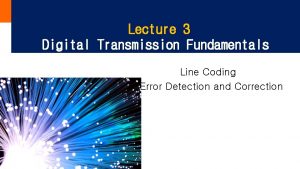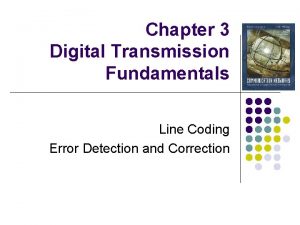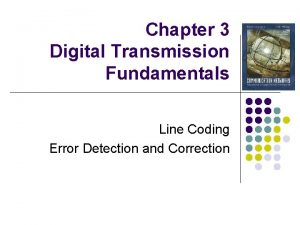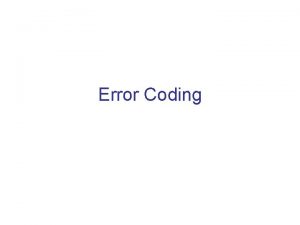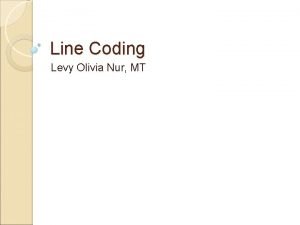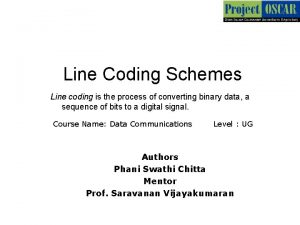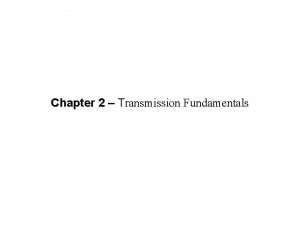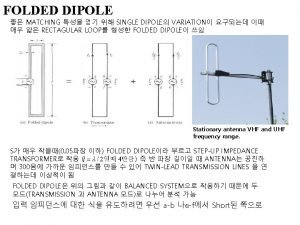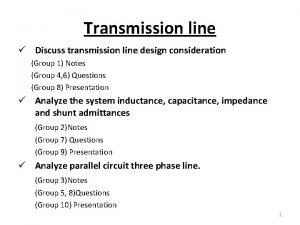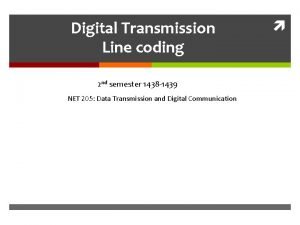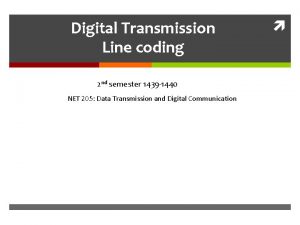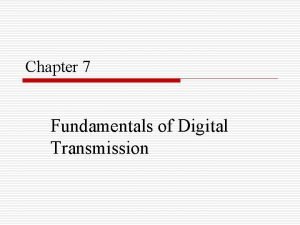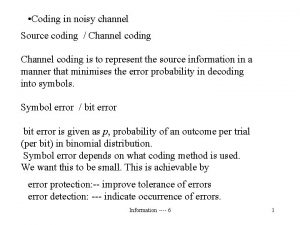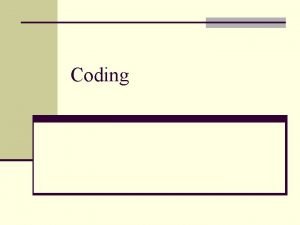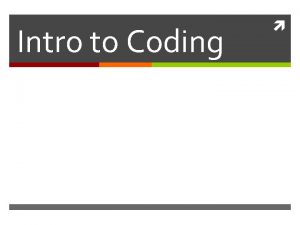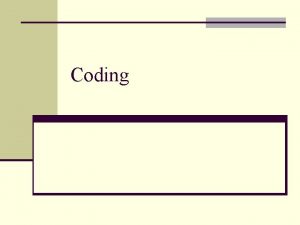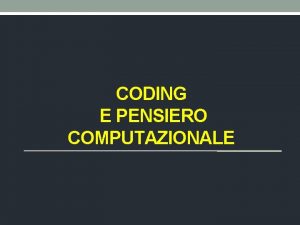Lecture 3 Digital Transmission Fundamentals Line Coding Error
























- Slides: 24

Lecture 3 Digital Transmission Fundamentals Line Coding Error Detection and Correction

Lecture 3 Digital Transmission Fundamentals Line Coding

What is Line Coding? • Mapping of binary information sequence into the digital signal that enters the channel • Ex. “ 1” maps to +A square pulse; “ 0” to –A pulse

Line coding examples 1 Unipolar NRZ Polar NRZ-inverted (differential encoding) Bipolar encoding Manchester encoding Differential Manchester encoding 0 1 1 1 0 0

Unipolar & Polar Non-Return-to-Zero (NRZ) 1 0 1 1 1 0 0 Unipolar NRZ Polar NRZ • • “ 1” maps to +A pulse “ 0” maps to no pulse High Average Power Long strings of A or 0 • Poor timing • Low-frequency content • Simple “ 1” maps to +A/2 pulse “ 0” maps to –A/2 pulse Better Average Power Long strings of +A/2 or –A/2 • Poor timing • Low-frequency content • Simple

Bipolar Code 1 0 1 1 1 Bipolar Encoding • • Three signal levels: {-A, 0, +A} “ 1” maps to +A or –A in alternation “ 0” maps to no pulse String of 1 s produces a square wave • Spectrum centered at T/2 • Long string of 0 s causes receiver to lose synch • Zero-substitution codes 0 0

Manchester code 1 0 1 1 1 Manchester Encoding • “ 1” maps into A/2 first T/2, -A/2 last T/2 • “ 0” maps into -A/2 first T/2, A/2 last T/2 • Every interval has transition in middle • Timing recovery easy • Uses double the minimum bandwidth • Simple to implement • Used in 10 -Mbps Ethernet & other LAN standards 0 0

Differential Coding 1 0 1 NRZ-inverted (differential encoding) Differential Manchester encoding • “ 1” mapped into transition in signal level • “ 0” mapped into no transition in signal level • Also used with Manchester coding 1 1 0 0

Lecture 3 Digital Transmission Fundamentals Line Coding Error Detection and Correction

Lecture 3 Digital Transmission Fundamentals Error Detection and Correction

Error Control • Digital transmission systems introduce errors • Applications require certain reliability level • Data applications require error-free transfer • Voice & video applications tolerate some errors • Error control used when transmission system does not meet application requirement • Error control ensures a data stream is transmitted to a certain level of accuracy despite errors • Two basic approaches: • Error detection & retransmission (ARQ: Automatic Retransmission Request) • Forward error correction (FEC)

Key Idea • • All transmitted data blocks (“codewords”) satisfy a pattern If received block doesn’t satisfy pattern, it is in error Redundancy: Only a subset of all possible blocks can be codewords Blindspot: when channel transforms a codeword into another codeword All inputs to channel satisfy pattern or condition User Encoder information Channel output Pattern checking Deliver user information or set error alarm

Single Parity Check l Append an overall parity check to k information bits Info Bits: Check Bit: Codeword: l l bk+1= b 1+ b 2+ b 3+ …+ bk modulo 2 (b 1, b 2, b 3, …, bk, , bk+1) All codewords have even # of 1 s Receiver checks to see if # of 1 s is even l l l b 1, b 2, b 3, …, bk All error patterns that change an odd # of bits are detectable All even-numbered patterns are undetectable Parity bit used in ASCII code

Example of Single Parity Code • Information (7 bits): (0, 1, 1, 0, 0) Parity Bit: b 8 = 0 + 1 +1 + 0 = 1 Codeword (8 bits): (0, 1, 1, 0, 0, 1) • If single error in bit 3 : (0, 1, 1, 0, 0, 1) • # of 1’s =5, odd • Error detected • If errors in bits 3 and 5: (0, 1, 1, 1, 0, 0, 0, 1) • # of 1’s =4, even • Error not detected

Two-Dimensional Parity Check • More parity bits to improve coverage • Arrange information as columns • Add single parity bit to each column • Add a final “parity” column • Used in early error control systems 1 0 0 0 1 Last column consists 1 0 0 of check bits for each 1 1 0 row 1 0 0 1 1 1 Bottom row consists of check bit for each column

Error-detecting capability 1 0 0 0 0 0 0 0 1 1 0 0 One error 1 0 0 1 1 0 0 1 1 1 1 0 0 1 0 0 0 1 1 0 0 Three errors 1 0 0 1 0 0 1 1 1 1 0 0 0 1 0 Arrows indicate failed check bits Two errors 1, 2, or 3 errors can always be detected; Not all patterns >4 errors can be detected Four errors (undetectable)

Other Error Detection Codes • • • Many applications require very low error rate Need codes that detect the vast majority of errors Single parity check codes do not detect enough errors Two-dimensional codes require too many check bits The following error detecting codes used in practice: • CRC Polynomial Codes

Polynomial Codes • • • Polynomials instead of vectors for codewords Polynomial arithmetic instead of check sums Implemented using shift-register circuits Also called cyclic redundancy check (CRC) codes Most data communications standards use polynomial codes for error detection • Polynomial codes also basis for powerful error-correction methods

Binary Polynomial Division • Binary vectors map to polynomials (ik-1 , ik-2 , …, i 2 , i 1 , i 0) ik-1 xk-1 + ik-2 xk-2 + … + i 2 x 2 + i 1 x + i 0 Addition: (x 7 + x 6 + 1) + (x 6 + x 5) = x 7 + x 6 + x 5 + 1 = x 7 +(1+1)x 6 + x 5 + 1 = x 7 +x 5 + 1 since 1+1=0 mod 2 Multiplication: (x + 1) (x 2 + x + 1) = x(x 2 + x + 1) + 1(x 2 + x + 1) = x 3 + x 2 + x + (x 2 + x + 1) = x 3 + 1

Binary Polynomial Division • Division with Decimal Numbers 34 35 ) 1222 105 divisor 17 2 140 32 quotient dividend = quotient x divisor +remainder 1222 = 34 x 35 + 32 remainder x 3 + x 2 + x • Polynomial Division divisor = q(x) quotient x 3 + x + 1 ) x 6 + x 5 x 6 + x 4 + x 3 Note: Degree of r(x) is less than degree of divisor dividend x 5 + x 4 + x 3 x 5 + x 3 + x 2 x 4 + x 2 + x x = r(x) remainder

Polynomial Coding • Code has binary generator polynomial of degree n–k g(x) = xn-k + gn-k-1 xn-k-1 + … + g 2 x 2 + g 1 x + 1 • k information bits define polynomial of degree k – 1 i(x) = ik-1 xk-1 + ik-2 xk-2 + … + i 2 x 2 + i 1 x + i 0 • Find remainder polynomial of at most degree n – k – 1 q(x) xn-ki(x) = q(x)g(x) + r(x) g(x) ) xn-k i(x) r(x) • Define the codeword polynomial of degree n – 1 b(x) = xn-ki(x) + r(x) n bits k bits n-k bits

Polynomial example: k = 4, n–k = 3 Generator polynomial: g(x)= x 3 + x + 1 Information: (1, 1, 0, 0) i(x) = x 3 + x 2 Encoding: x 3 i(x) = x 6 + x 5 x 3 + x 2 + x x 3 + x + 1 ) x 6 + x 5 x 6 + 1110 1011 ) 1100000 1011 x 4 + x 3 1110 x 5 + x 4 + x 3 x 5 + x 3 + x 2 x 4 + 1011 x 2 + x x Transmitted codeword: b(x) = x 6 + x 5 + x b = (1, 1, 0, 0, 0, 1, 0) 1010 1011 010

The Pattern in Polynomial Coding • All codewords satisfy the following pattern: b(x) = xn-ki(x) + r(x) = q(x)g(x) • All codewords are a multiple of g(x)! • Receiver should divide received n-tuple by g(x) and check if remainder is zero • If remainder is nonzero, then received n-tuple is not a codeword

Standard Generator Polynomials CRC = cyclic redundancy check • CRC-8: = x 8 + x 2 + x + 1 ATM • CRC-16: = x 16 + x 15 + x 2 + 1 = (x + 1)(x 15 + x + 1) Bisync • CCITT-16: = x 16 + x 12 + x 5 + 1 • CCITT-32: HDLC, XMODEM, V. 41 IEEE 802, Do. D, V. 42 = x 32 + x 26 + x 23 + x 22 + x 16 + x 12 + x 11 + x 10 + x 8 + x 7 + x 5 + x 4 + x 2 + x + 1
 Apa itu selective
Apa itu selective Open coding adalah
Open coding adalah Nrz format
Nrz format Line by line coding
Line by line coding Axial coding vs open coding
Axial coding vs open coding Coding dna and non coding dna
Coding dna and non coding dna Describe manual transmission fundamentals.
Describe manual transmission fundamentals. 01:640:244 lecture notes - lecture 15: plat, idah, farad
01:640:244 lecture notes - lecture 15: plat, idah, farad What is crc in computer network
What is crc in computer network Crc error detection
Crc error detection Timing error in asynchronous transmission
Timing error in asynchronous transmission 66454 subject code
66454 subject code Disadvantages of pulse amplitude modulation
Disadvantages of pulse amplitude modulation Digital data transmission
Digital data transmission Analog digital transmission
Analog digital transmission Analogue and digital transmission in computer networks
Analogue and digital transmission in computer networks Timex digital flex tech hrm sensor
Timex digital flex tech hrm sensor Subjective fidelity criteria in digital image processing
Subjective fidelity criteria in digital image processing Digital image processing
Digital image processing Huffman coding
Huffman coding Arithmetic coding in digital image processing
Arithmetic coding in digital image processing Type 1 or type 2 error statistics
Type 1 or type 2 error statistics Type 2 vs type 1 error
Type 2 vs type 1 error Can dead men vote twice
Can dead men vote twice Hypothesis examples in research
Hypothesis examples in research


